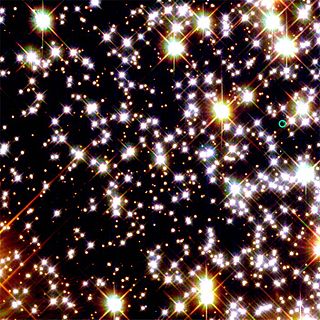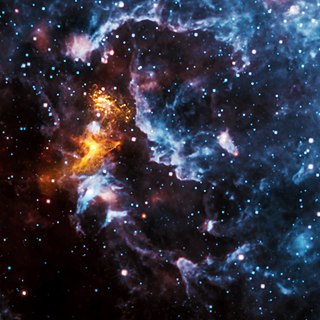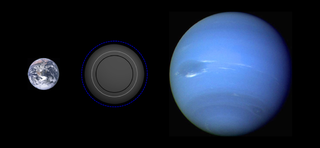
A neutron star is the collapsed core of a massive supergiant star, which had a total mass of between 10 and 25 solar masses, possibly more if the star was especially metal-rich. Except for black holes and some hypothetical objects, neutron stars are the smallest and densest currently known class of stellar objects. Neutron stars have a radius on the order of 10 kilometres (6 mi) and a mass of about 1.4 solar masses. They result from the supernova explosion of a massive star, combined with gravitational collapse, that compresses the core past white dwarf star density to that of atomic nuclei.

PSR B1620−26 b is an exoplanet located approximately 12,400 light-years from Earth in the constellation of Scorpius. It bears the unofficial nicknames "Methuselah" and "the Genesis planet" due to its extreme age. The planet is in a circumbinary orbit around the two stars of PSR B1620−26 and is the first circumbinary planet ever confirmed. It is also the first planet found in a globular cluster. The planet is one of the oldest known extrasolar planets, believed to be about 12.7 billion years old.

PSR B1620−26 is a binary star system located at a distance of 3,800 parsecs in the globular cluster of Messier 4 in the constellation of Scorpius. The system is composed of a pulsar and a white dwarf star. As of 2000, the system is also confirmed to have an exoplanet orbiting the two stars.
PSR B1257+12, previously designated PSR 1257+12, alternatively designated PSR J1300+1240, is a millisecond pulsar located 2,300 light-years from the Sun in the constellation of Virgo, rotating at about 161 times per second. It is also named Lich, after a powerful, fictional undead creature of the same name.

Pulsar planets are planets that are found orbiting pulsars, or rapidly rotating neutron stars. The first such planets to be discovered were around a millisecond pulsar and were the first extrasolar planets to be confirmed as discovered.

EF Eridani is a variable star of the type known as polars, AM Herculis stars, or magnetic cataclysmic variable stars. Historically it has varied between apparent magnitudes 14.5 and 17.3, although since 1995 it has generally remained at the lower limit. The star system consists of a white dwarf with a substellar-mass former star in orbit.

A pulsar is a highly magnetized rotating neutron star that emits beams of electromagnetic radiation out of its magnetic poles. This radiation can be observed only when a beam of emission is pointing toward Earth, and is responsible for the pulsed appearance of emission. Neutron stars are very dense and have short, regular rotational periods. This produces a very precise interval between pulses that ranges from milliseconds to seconds for an individual pulsar. Pulsars are one of the candidates for the source of ultra-high-energy cosmic rays.

A carbon planet is a theoretical type of planet that contains more carbon than oxygen. Carbon is the fourth most abundant element in the universe by mass after hydrogen, helium, and oxygen.

A millisecond pulsar (MSP) is a pulsar with a rotational period less than about 10 milliseconds. Millisecond pulsars have been detected in radio, X-ray, and gamma ray portions of the electromagnetic spectrum. The leading theory for the origin of millisecond pulsars is that they are old, rapidly rotating neutron stars that have been spun up or "recycled" through accretion of matter from a companion star in a close binary system. For this reason, millisecond pulsars are sometimes called recycled pulsars.

A binary pulsar is a pulsar with a binary companion, often a white dwarf or neutron star. Binary pulsars are one of the few objects which allow physicists to test general relativity because of the strong gravitational fields in their vicinities. Although the binary companion to the pulsar is usually difficult or impossible to observe directly, its presence can be deduced from the timing of the pulses from the pulsar itself, which can be measured with extraordinary accuracy by radio telescopes.

PSR B1257+12 C, alternatively designated PSR B1257+12 d and also named Phobetor, is a super-Earth exoplanet orbiting the pulsar PSR B1257+12 approximately 2,315 light-years away from Earth in the constellation of Virgo. It was one of the first planets ever discovered outside the Solar System. It was discovered using the pulsar timing method, where the regular pulses of a pulsar are measured to determine if there is a planet causing variations in the data.
PSR J1903+0327 is a millisecond pulsar in a highly eccentric binary orbit.

PSR B1937+21 is a pulsar located in the constellation Vulpecula a few degrees in the sky away from the first discovered pulsar, PSR B1919+21. The name PSR B1937+21 is derived from the word "pulsar" and the declination and right ascension at which it is located, with the "B" indicating that the coordinates are for the 1950.0 epoch. PSR B1937+21 was discovered in 1982 by Don Backer, Shri Kulkarni, Carl Heiles, Michael Davis, and Miller Goss.

A planetary-mass object (PMO), planemo, or planetary body is by geophysical definition of celestial objects any celestial object massive enough to achieve hydrostatic equilibrium, but not enough to sustain core fusion like a star.

The Black Widow Pulsar is an eclipsing binary millisecond pulsar in the Milky Way. Discovered in 1988, it is located roughly 6,500 light-years away from Earth. It orbits with a brown dwarf or Super-Jupiter companion with a period of 9.2 hours with an eclipse duration of approximately 20 minutes. When it was discovered, it was the first such pulsar known. The prevailing theoretical explanation for the system implied that the companion is being destroyed by the strong powerful outflows, or winds, of high-energy particles caused by the neutron star; thus, the sobriquet black widow was applied to the object. Subsequent to this, other objects with similar features have been discovered, and the name has been applied to the class of millisecond pulsars with an ablating companion.
PSR J1614–2230 is a pulsar in a binary system with a white dwarf in the constellation Scorpius. It was discovered in 2006 with the Parkes telescope in a survey of unidentified gamma ray sources in the Energetic Gamma Ray Experiment Telescope catalog. PSR J1614–2230 is a millisecond pulsar, a type of neutron star, that spins on its axis roughly 317 times per second, corresponding to a period of 3.15 milliseconds. Like all pulsars, it emits radiation in a beam, similar to a lighthouse. Emission from PSR J1614–2230 is observed as pulses at the spin period of PSR J1614–2230. The pulsed nature of its emission allows for the arrival of individual pulses to be timed. By measuring the arrival time of pulses, astronomers observed the delay of pulse arrivals from PSR J1614–2230 when it was passing behind its companion from the vantage point of Earth. By measuring this delay, known as the Shapiro delay, astronomers determined the mass of PSR J1614–2230 and its companion. The team performing the observations found that the mass of PSR J1614–2230 is 1.97 ± 0.04 M☉. This mass made PSR J1614–2230 the most massive known neutron star at the time of discovery, and rules out many neutron star equations of state that include exotic matter such as hyperons and kaon condensates.

PSR J1719−1438 b is an extrasolar planet that was discovered on August 25, 2011, in orbit around PSR J1719−1438, a millisecond pulsar. The pulsar planet is most likely composed largely of crystalline carbon but with a density far greater than diamond. PSR J1719-1438 b orbits so closely to its host star that its orbit would fit inside the Sun. The existence of such carbon planets had been theoretically postulated.

PSR J0348+0432 is a pulsar–white dwarf binary system in the constellation Taurus. It was discovered in 2007 with the National Radio Astronomy Observatory's Robert C. Byrd Green Bank Telescope in a drift-scan survey.
In astronomy, the binary mass function or simply mass function is a function that constrains the mass of the unseen component in a single-lined spectroscopic binary star or in a planetary system. It can be calculated from observable quantities only, namely the orbital period of the binary system, and the peak radial velocity of the observed star. The velocity of one binary component and the orbital period provide information on the separation and gravitational force between the two components, and hence on the masses of the components.

PSR J0952–0607 is a massive millisecond pulsar in a binary system, located between 3,200–5,700 light-years (970–1,740 pc) away from Earth in the constellation Sextans. It holds the record for being the most massive neutron star known as of 2022, with a mass 2.35±0.17 times as much as the Sun—potentially close to the Tolman–Oppenheimer–Volkoff mass upper limit for neutron stars. The pulsar rotates at a frequency of 707 Hz, making it the second-fastest-spinning pulsar known, and the fastest-spinning pulsar that is located in the Milky Way.




















